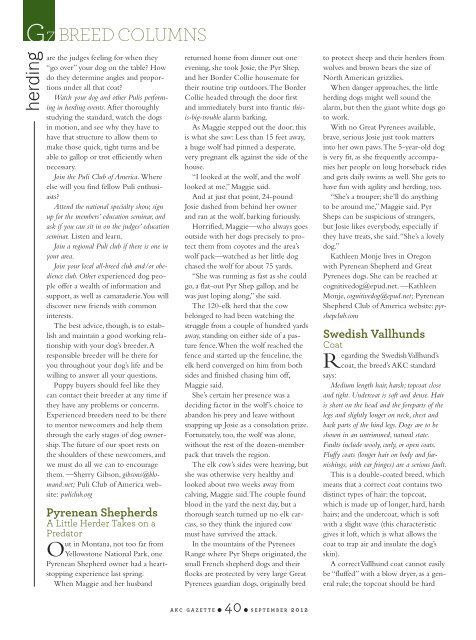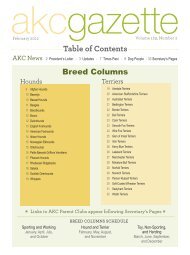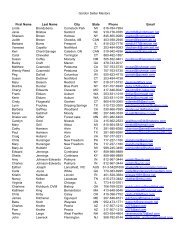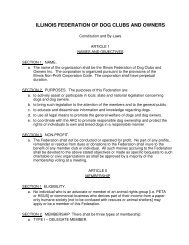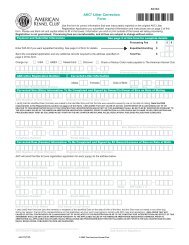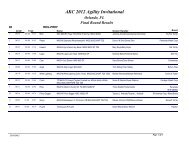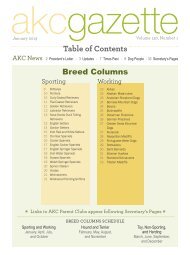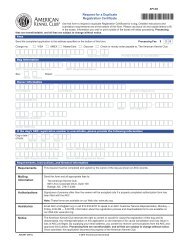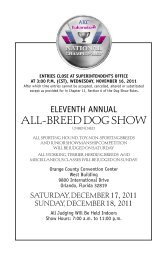Download - Parent Directory - American Kennel Club
Download - Parent Directory - American Kennel Club
Download - Parent Directory - American Kennel Club
- No tags were found...
You also want an ePaper? Increase the reach of your titles
YUMPU automatically turns print PDFs into web optimized ePapers that Google loves.
GZ BREED COLUMNSherdingare the judges feeling for when they“go over” your dog on the table? Howdo they determine angles and proportionsunder all that coat?Watch your dog and other Pulis performingin herding events. After thoroughlystudying the standard, watch the dogsin motion, and see why they have tohave that structure to allow them tomake those quick, tight turns and beable to gallop or trot efficiently whennecessary.Join the Puli <strong>Club</strong> of America. Whereelse will you find fellow Puli enthusiasts?Attend the national specialty show, signup for the members’ education seminar, andask if you can sit in on the judges’ educationseminar. Listen and learn.Join a regional Puli club if there is one inyour area.Join your local all-breed club and/or obedienceclub. Other experienced dog peopleoffer a wealth of information andsupport, as well as camaraderie. You willdiscover new friends with commoninterests.The best advice, though, is to establishand maintain a good working relationshipwith your dog’s breeder. Aresponsible breeder will be there foryou throughout your dog’s life and bewilling to answer all your questions.Puppy buyers should feel like theycan contact their breeder at any time ifthey have any problems or concerns.Experienced breeders need to be thereto mentor newcomers and help themthrough the early stages of dog ownership.The future of our sport rests onthe shoulders of these newcomers, andwe must do all we can to encouragethem. —Sherry Gibson, gibsons@blomand.net;Puli <strong>Club</strong> of America website:puliclub.orgPyrenean ShepherdsA Little Herder Takes on aPredatorOut in Montana, not too far fromYellowstone National Park, onePyrenean Shepherd owner had a heartstoppingexperience last spring.When Maggie and her husbandreturned home from dinner out oneevening, she took Josie, the Pyr Shep,and her Border Collie housemate fortheir routine trip outdoors. The BorderCollie headed through the door firstand immediately burst into frantic thisis-big-troublealarm barking.As Maggie stepped out the door, thisis what she saw: Less than 15 feet away,a huge wolf had pinned a desperate,very pregnant elk against the side of thehouse.“I looked at the wolf, and the wolflooked at me,” Maggie said.And at just that point, 24-poundJosie dashed from behind her ownerand ran at the wolf, barking furiously.Horrified, Maggie—who always goesoutside with her dogs precisely to protectthem from coyotes and the area’swolf pack—watched as her little dogchased the wolf for about 75 yards.“She was running as fast as she couldgo, a flat-out Pyr Shep gallop, and hewas just loping along,” she said.The 120-elk herd that the cowbelonged to had been watching thestruggle from a couple of hundred yardsaway, standing on either side of a pasturefence. When the wolf reached thefence and started up the fenceline, theelk herd converged on him from bothsides and finished chasing him off,Maggie said.She’s certain her presence was adeciding factor in the wolf’s choice toabandon his prey and leave withoutsnapping up Josie as a consolation prize.Fortunately, too, the wolf was alone,without the rest of the dozen-memberpack that travels the region.The elk cow’s sides were heaving, butshe was otherwise very healthy andlooked about two weeks away fromcalving, Maggie said. The couple foundblood in the yard the next day, but athorough search turned up no elk carcass,so they think the injured cowmust have survived the attack.In the mountains of the PyreneesRange where Pyr Sheps originated, thesmall French shepherd dogs and theirflocks are protected by very large GreatPyrenees guardian dogs, originally bredto protect sheep and their herders fromwolves and brown bears the size ofNorth <strong>American</strong> grizzlies.When danger approaches, the littleherding dogs might well sound thealarm, but then the giant white dogs goto work.With no Great Pyrenees available,brave, serious Josie just took mattersinto her own paws. The 5-year-old dogis very fit, as she frequently accompaniesher people on long horseback ridesand gets daily swims as well. She gets tohave fun with agility and herding, too.“She’s a trouper; she’ll do anythingto be around me,” Maggie said. PyrSheps can be suspicious of strangers,but Josie likes everybody, especially ifthey have treats, she said. “She’s a lovelydog.”Kathleen Monje lives in Oregonwith Pyrenean Shepherd and GreatPyrenees dogs. She can be reached atcognitivedog@epud.net. —KathleenMonje, cognitivedog@epud.net; PyreneanShepherd <strong>Club</strong> of America website: pyrshepclub.comSwedish VallhundsCoatRegarding the Swedish Vallhund’scoat, the breed’s AKC standardsays:Medium length hair, harsh; topcoat closeand tight. Undercoat is soft and dense. Hairis short on the head and the foreparts of thelegs and slightly longer on neck, chest andback parts of the hind legs. Dogs are to beshown in an untrimmed, natural state.Faults include wooly, curly, or open coats.Fluffy coats (longer hair on body and furnishings,with ear fringes) are a serious fault.This is a double-coated breed, whichmeans that a correct coat contains twodistinct types of hair: the topcoat,which is made up of longer, hard, harshhairs; and the undercoat, which is softwith a slight wave (this characteristicgives it loft, which is what allows thecoat to trap air and insulate the dog’sskin).A correct Vallhund coat cannot easilybe “fluffed” with a blow dryer, as a generalrule; the topcoat should be hardA K C G A Z E T T E • 40 • S E P T E M B E R 2 0 1 2


